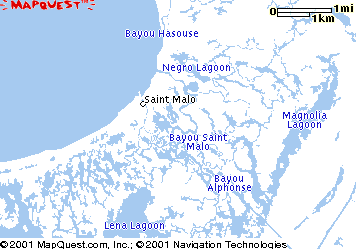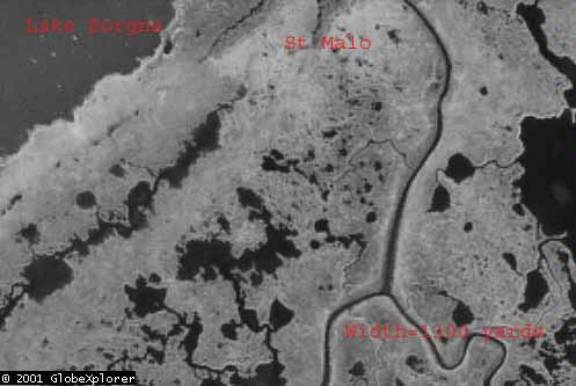

Aerial Photo of Saint Malo- 2001
French Saint Malo
(you are listening to the wave sound of Louisianafishing.com)Magellan found the Southern Passage in 1520 and sailed through the treacherous southern straight of South America on his way to the Philippines now known as the Straight of Magellan. He named it “Espritu Santo” for the same reason that in almost the same year Spanish sailors stumbled on the bowels of the Mississippi Rivers in search for the Northern Passage and gold. The sailors also named the river, “Espiritu Santo” but the river that was the original west coast of the United States kept its Indian name. The French connection from the north brought to the banks new French bastions, inheriting the king’s name, St Louis, Louisville, and Louisiana from the French King. Baton Rogue became the capital city and New Orleans was the queen city of the French Empire in America. The French crossed Lake Borgne south of the French Quarter away from Bourbon Street and charted the French Bayous (not a French world like Bayonne but from the Choctaw Indian tribe “bayuk” for body of water)
Saint Malo is located in the northern seaports (Brittany) in France and is
famous for sailing. War historians largely credited the Victory in Europe in
WWII to the very successful beachhead landing in northern Europe. The Landing
Crafts were built by the Huggins Company in New Orleans and made practice runs
on the bayous nearby. These boats, Eisenhower claimed, won the war as the
boats' sea trials completed in the bayous of the gulf water made Normandy a
perfect beach invasion site.

The Manila men sailors found the landscape compatible to their love of the sea. In the 18th century, they settled in the French Bayou because the island environment in the Philippines was very similar. They started onboard the famous Manila galleon and escaped in New Orleans. Louisiana was admitted to the Union in 1812 also which marked the near end of the Manila galleon trade (1565-1815.)


Filipino Sailor in Bayou du Malo circa 1880
Melting Pot in the Bayous
Take a cup of Chactaw and add Frenchman; aventuriers le bois and
Acadian refugees from Nova Scotia.
Blend in a Mississippi Bubble, a sprinkling of fugitives from justice,
and a few filles de joie Now sift in Catalans, Spanish
planters,
gens de couleur, and a large gombo negre Make a Code Noir
and some Quadroon Balls
Stir together gently, adding Dalmatian oystermen, FILIPINO shrimpers,
Germans, and “Kentucks” (often rather tough)
Add a pinch of pirates Simmer slowly under six flags
Serves most of southern Louisiana.
Ethnic diversity in the Mississippi Delta as described in Oliver Evans’ Poem
(from the book “Filipinos in New Orleans”)
 St Malo
Map circa 1880 (Harpers Weekly)
St Malo
Map circa 1880 (Harpers Weekly)

Close-up of Saint Malo Region (1/2 mile radius)
Nestor Palugod EnriquezPhix7@yahoo.com
Go back to Filipino Home Index